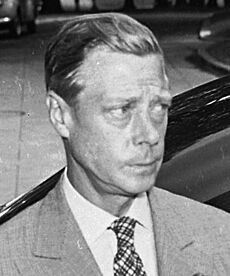History of the Bahamas facts for kids
The first people to arrive in the islands now known as The Bahamas were the Lucayans. They were a group of Taino who spoke an Arawakan language. They came to the islands between about 500 and 800 AD from other islands in the Caribbean.
The recorded history of the Bahamas began on October 12, 1492. This is when Christopher Columbus landed on an island called Guanahani. He renamed it San Salvador Island during his first trip to the New World. The first lasting European settlement was in 1648 on Eleuthera. During the 18th century slave trade, many enslaved Africans were brought to the Bahamas. Their descendants now make up 85% of the Bahamian population. The Bahamas became independent from the United Kingdom on July 10, 1973.
Contents
Early Settlers of the Bahamas
Between 500 and 800 AD, the Taínos started traveling in dugout canoes from Hispaniola or Cuba to the Bahamas. They slowly spread across the islands over about 800 years. By 1500, their population reached around 40,000 people. The most people lived in the south-central Bahamas. Fewer people lived in the northern islands because they had been settled more recently. Lucayan villages have been found on the nineteen largest islands and on smaller islands close to them.
European Arrival and Spanish Rule
In 1492, Christopher Columbus sailed from Spain with three ships: the Niña, the Pinta, and the Santa Maria. He was looking for a direct way to Asia. On October 12, Columbus reached an island in the Bahamas. He claimed it for Spain. The Lucayans called this island Guanahani, and Columbus named it San Salvador. Many believe this island is the one now officially called San Salvador Island. Columbus visited other islands in the Bahamas before sailing to Cuba and then Hispaniola.
The Spanish were not very interested in the Bahamas. They mainly saw it as a place to find people to enslave. Over the next 30 years, almost all 40,000 Lucayans were taken to other islands to work. By 1520, the Spanish could only find eleven Lucayans left. The islands were left empty for 130 years. Since there was no gold and no people, Spain left the Bahamas. They officially gave the islands to Britain in 1783.
When Europeans first arrived, they said the Bahamas were covered in thick forests. These forests were cut down to make way for sugarcane plantations. The forests have not grown back since.
First English Settlements
In 1648, a group of Puritans from Bermuda sailed to the Bahamas. They were led by William Sayle and called "The Company of Adventurers for the Plantation of the Islands of Eleutheria." They wanted to start a new colony. Bermuda was getting too crowded, and the Bahamas offered religious freedom and new chances to make money. Their main ship, the William, crashed on a reef near what is now Eleuthera Island. They lost all their supplies.
More settlers arrived, including Europeans and people of African descent from Bermuda. They also received help from Virginia and New England. However, the Eleuthera colony struggled for many years. This was due to poor soil, arguments among settlers, and conflicts with the Spanish. By the mid-1650s, many settlers went back to Bermuda. Those who stayed founded communities on Harbour Island and Saint George's Cay (Spanish Wells). By 1670, about 20 families lived in these Eleuthera communities.
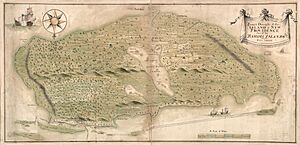
In 1666, other settlers from Bermuda moved to New Providence. This island quickly became the main center for people and business in the Bahamas. By 1670, almost 500 people lived there. Unlike the Eleuthera settlers, who were mostly farmers, the first New Providence settlers made money from the sea. They salvaged goods from shipwrecks, made salt, and caught fish, turtles, conchs, and ambergris. Farmers from Bermuda soon followed, finding good land on New Providence.
Neither the Eleuthera nor the New Providence settlements were officially recognized by English law. In 1670, the Proprietors of Carolina were given control of the Bahamas. But the governors they sent found it hard to control the independent people of New Providence.
The early settlers lived much like they had in Bermuda. They fished, hunted turtles, whales, and seals, found ambergris, and made salt on drier islands. They also cut down trees for lumber, dyewood, and medicine. Another important activity was wrecking, which meant salvaging goods from shipwrecks. The Bahamas were near important shipping routes, so shipwrecks were common. Salvaging wrecks was the most profitable job for Bahamians.
The Republic of Pirates
The Bahamians soon had problems with the Spanish over salvaging wrecks. Bahamian wreckers chased the Spanish away from their wrecked ships. They even attacked Spanish salvagers and took goods the Spanish had already found. When the Spanish raided the Bahamas, the Bahamians hired privateers to attack Spain. This happened even when England and Spain were at peace. In 1684, the Spanish burned the settlements on New Providence and Eleuthera. After this, most people left. New Providence was settled again in 1686 by colonists from Jamaica.
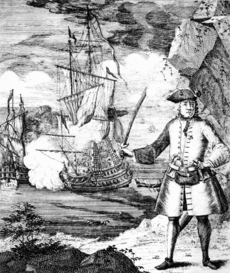
In the 1690s, English privateers used the Bahamas as a base during a war with France. In 1696, Henry Every, a pirate captain, brought his ship Fancy into Nassau harbor. It was full of pirate treasure. Every bribed the governor with gold and silver. He also left him the Fancy, which still had 50 tons of elephant tusks and 100 barrels of gunpowder. After peace with France in 1697, many privateers became pirates. Nassau, the Bahamian capital founded in 1694, became their main base. The governors often pretended to stop the pirates, but most were accused of working with them. By 1701, England was at war with France and Spain. In 1703 and 1706, French and Spanish fleets attacked and looted Nassau. Some settlers left, and the Proprietors gave up trying to govern the islands.
With no working government, English privateers used Nassau as their base. This time was called a "privateers' republic" and lasted for eleven years. The raiders attacked French and Spanish ships. In return, French and Spanish forces burned Nassau several times. The War of the Spanish Succession ended in 1714. But some privateers were slow to hear the news or did not want to stop. They became pirates. One estimate says there were at least 1,000 pirates in the Bahamas in 1713. This was more than the 200 families of permanent settlers.
The "privateers' republic" in Nassau became a "pirates' republic." At least 20 pirate captains used Nassau or other places in the Bahamas as a home port. These included Henry Jennings, Edward Teach (Blackbeard), Benjamin Hornigold, and Stede Bonnet. Many settler families moved from New Providence to Eleuthera or Abaco to avoid the pirates. However, people on Harbor Island were happy to help the pirates. Merchants from New England and Virginia came there to trade supplies for pirate goods. Piracy led to frequent and harsh attacks by the French and Spanish, but these attacks were not very effective.
British Control Returns
In 1713, Woodes Rogers thought of leading a trip to Madagascar to stop pirates there and start a British colony. His friends convinced him to deal with the pirates in the Bahamas instead. Rogers and others formed a company to pay for the trip. They convinced the Proprietors of Carolina to give control of the Bahamas government to the king. In 1717, King George made Rogers the governor of the Bahamas. He also offered a pardon to any pirate who surrendered to a British governor within one year.

News of the new governor and the pardons reached Nassau before Rogers arrived. Some pirates wanted to accept the pardon and stop being pirates. Henry Jennings and Christopher Winter sailed off to find British officials to confirm their acceptance.
Others were not ready to give up. Many were Jacobites, who supported the old royal family, the House of Stuart. They saw themselves as enemies of the new king, George. Others just liked being rebels or thought they were better off as pirates than trying to earn an honest living. When a Royal Navy ship brought official news of the pardon, many pirates planned to accept. But soon, those who did not want to surrender took control. They forced the Navy ship to leave.
Blackbeard, Stede Bonnet, Nicholas Brown, and Edmond Condent left the Bahamas for other places. Charles Vane, with "Calico Jack" Rackham and Edward England in his crew, became well-known at this time. Vane tried to organize resistance against the British. He even asked James Francis Edward Stuart, the Stuart pretender, for help to hold the Bahamas and capture Bermuda for the Stuarts. But help from the Stuarts did not arrive. As Rogers' arrival got closer, Vane and his crew prepared to leave Nassau.
Woodes Rogers arrived in Nassau in late July 1718. He had his own warship and three ships from his company. He also had an escort of three Royal Navy ships. Vane's ship was trapped in Nassau harbor. His crew set their ship on fire and sent it towards Rogers' ships. They escaped in the confusion on a smaller ship they had taken from another pirate. The remaining people in Nassau welcomed Rogers. There were about 200 settlers and 500 to 700 pirates who wanted pardons. The most famous pirate to surrender was Benjamin Hornigold. After the pirates surrendered, the Proprietors rented their land in the Bahamas to Rogers' company for 21 years.
Rogers controlled Nassau, but Charles Vane was still free and threatened to drive the governor out. Rogers learned that the King of Spain wanted to remove the English from the islands. So, Rogers worked to make Nassau's defenses stronger. He lost almost 100 men to an unknown disease. The Navy ships left for other duties. Rogers sent four of his ships to Havana to tell the Spanish governor he was stopping piracy and to trade for supplies. The crews of former pirates and men who came with Rogers all turned to piracy. The former pirate Benjamin Hornigold later caught ten men at Green Turtle Cay as part of Rogers' efforts to stop piracy.
Vane attacked several small settlements in the Bahamas. But after he refused to attack a stronger French ship, he was removed as captain for being a coward. "Calico Jack" Rackham took his place. Vane never returned to the Bahamas. He was later caught, found guilty, and executed in Jamaica. After almost being caught by Jamaican privateers, and hearing that the king had extended the deadline for pirate pardons, Rackham and his crew returned to Nassau to surrender to Woodes Rogers.

In August 1720, Rackham stole the sloop William from Nassau harbor. With him was a small crew that included female pirates Anne Bonny and Mary Read. In October, Rackham, Bonny, and Read were captured and taken to Jamaica. They were found guilty of piracy, and Rackham was executed. Bonny and Read were sent to prison. They said they were pregnant, which meant they could not be executed. Read died in prison, but what happened to Bonny is not known.
When Britain and Spain went to war again in 1719, many former pirates were hired by the British government as privateers. A Spanish invasion fleet set out for the Bahamas. But it was sent to Pensacola, Florida instead when the French took it over. Rogers kept improving Nassau's defenses. He spent his own money and went deeply into debt to do so. In 1720, the Spanish finally attacked Nassau. Rogers returned to Britain in 1722 to ask for his money back. But he found he had been replaced as governor. He was sent to debtors' prison, but his debts were later cleared, and he was released.
The king later gave him a pension, starting from 1721. In 1728, Rogers was made Governor of the Bahamas for a second time. He closed the colony's assembly when it would not approve taxes to fix Nassau's defenses. He died in Nassau in 1732.
The Later 1700s
In 1741, Governor John Tinker and Peter Henry Bruce built Fort Montague. The Governor also reported a big increase in privateering in the Thirteen Colonies in North America. He also said that over 2300 fancy houses were built. In 1768, Governor William Shirley filled in swamps where mosquitoes bred and made Nassau bigger.
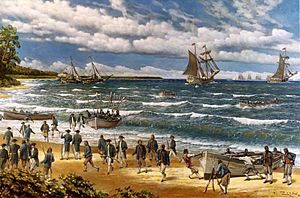
During the American War of Independence, the Bahamas were attacked by American and allied forces several times. In 1776, American forces launched an attack against Nassau by land and sea. This led to them occupying Nassau for two weeks. In 1782, Spanish forces led by General Galvez captured the Bahamas. A British-American Loyalist group led by Colonel Andrew Deveaux recaptured the islands in 1783.
After the American Revolution, the British gave land to American Loyalists. These were people who had left the newly formed United States. The small population of the Bahamas tripled in a few years. The Loyalists grew cotton as a crop to sell. But it failed because of insect damage and poor soil. Besides the enslaved people they brought with them, the plantation owners brought in more enslaved Africans for labor.
Most of the people living in the islands today are descendants of the enslaved people brought to work on the Loyalist plantations. Also, thousands of captured Africans were freed from foreign slave ships by the British navy. This happened after the British slave trade was ended in 1807. These freed people were resettled in the Bahamas as free persons.
The 1800s in the Bahamas
In the early 1820s, after Florida was given from Spain to the United States, hundreds of enslaved Africans and Black Seminoles escaped from Florida. Most settled on Andros Island in the Bahamas. Three hundred escaped in a large group in 1823. Even though a lighthouse was built at Cape Florida in 1825, enslaved people continued to find freedom in the Bahamas. In August 1834, the traditional plantation life ended. This was when the British ended slavery in most of its colonies. Freed people chose to work on their own small plots of land if they could.
In the 1830s and 1840s, problems grew between Britain and the United States. This happened after American merchant ships, part of the slave trade along the coast, entered Nassau or crashed on its reefs. These included the Hermosa (1840) and the Creole (1841). The Creole was brought in after an enslaved revolt on board. Britain had told other nations that enslaved people brought into Bahamian and Bermudan waters would be freed. Britain refused US efforts to get them back. In 1853, Britain and the US signed a treaty to settle claims dating back to 1814. They paid each other in 1855.
After slavery ended, Caribbean societies had a strict system of racial groups. This was made worse by the unfair distribution of wealth and power. There were three main groups: whites, mixed-race people, and mostly blacks, who were the largest group. This system lasted until the 1940s and beyond in some places. Like African Americans, many people also have European and Native American ancestors. Caribbean societies still work to solve racial issues.
The Bahamas during the American Civil War became a busy place for Confederate ships trying to avoid a blockade. They brought cotton to be sent to England's factories. They also brought in weapons and ammunition. But these activities did not bring lasting wealth to the islands. Attempts to grow different crops for export also failed.
The Bahamas in the 20th Century
In 1911, there was a brief idea to make the Bahamas part of Canada. Many people in Nassau supported this, as did the head of Sun Life Financial, a Canadian insurance company. But the idea failed. One reason was that the British government did not want to join a mostly black colony with a mostly white country.
During World War I, groups like the Imperial Order of the Daughters of Empire and the Bahamas Red Cross Guild collected money, food, and clothes for soldiers and people in Europe. "The Gallant Thirty" Bahamians went to join the British West Indies Regiment as early as 1915. As many as 1,800 Bahamians served in the armed forces of Canada, Britain, and the United States.
World War II and the Duke of Windsor
Oakes Field, the first airport in the Bahamas, opened in Nassau in January 1940. It was named after Harry Oakes, a rich man who gave a lot of money for it. Before that, most flying in the Bahamas was done with seaplanes.
The Duke of Windsor became the governor of the Bahamas. He arrived in August 1940 with his new Duchess. They were shocked by the condition of Government House. But they "tried to make the best of a bad situation." He did not enjoy the job and called the islands "a third-class British colony." He opened the local parliament on October 29, 1940, and they visited the 'Out Islands' that November.
However, the Duke was praised for trying to help with poverty on the islands. He was also praised for solving civil unrest in Nassau in June 1942. There was a "full-scale riot" over low wages. Even though he blamed the problems on "troublemakers – communists" and "men of Central European Jewish descent," he helped calm the situation. The Duke resigned from his post on March 16, 1945.
Canadian Soldiers in the Bahamas
In April 1942, the United Kingdom asked Canada to send military help to Nassau. Part of the reason was to protect H.R.H. the Duke of Windsor. The No. 33 company of the Veterans Guard of Canada was formed and arrived in June. Another Canadian company, The Pictou Highlanders, replaced them in 1943. The Canadian soldiers left Nassau in 1946.
After World War II
The wartime airfield became Nassau's international airport in 1957. This helped tourism grow a lot, especially after Havana was closed to American tourists in 1961. Freeport, on the island of Grand Bahama, was set up as a free trade zone in the 1950s. Bank secrecy and no company or income taxes led to fast growth in the offshore financial industry after the war.
Modern political changes began after World War II. The first political parties were formed in the 1950s. The Progressive Liberal Party was created in 1953, and the United Bahamian Party was formed in 1956.
The Bahamas gained self-government in 1964. Sir Roland Symonette, from the United Bahamian Party, became the first Premier. Sir Lynden O. Pindling, leader of the Progressive Liberal Party, became the first black Premier of the colony in 1967. In 1968, his title was changed to Prime Minister.
Independent Bahamas
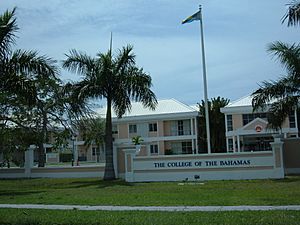
The Bahamas became fully independent as a Commonwealth realm within the Commonwealth of Nations on July 10, 1973. Sir Milo Butler was named the first Governor-General of the Bahamas. He was the official representative of Queen Elizabeth II after independence. Pindling was prime minister until 1992. He was followed by Hubert Ingraham, leader of the Free National Movement, who was prime minister until 2002.
The College of the Bahamas was founded in 1974. It provided higher education for the nation. In 2016, the college became the University of the Bahamas. It offers bachelor's, master's, and associate degrees at three campuses and research centers across the Bahamas.
The Bahamian economy has done well since the 1950s, based on tourism and offshore finance. However, there are still big challenges in areas like education, health care, housing, and people illegally moving from Haiti.
In the 2002 Bahamian general election, the PLP returned to power with Perry Christie as leader. Ingraham was prime minister again from 2007 to 2012, followed by Christie again from 2012 to 2017. With slow economic growth, Bahamians re-elected the FNM in 2017. Hubert Minnis became the fourth prime minister.
In September 2019, Hurricane Dorian hit the Abaco Islands and Grand Bahama. It was a Category 5 storm and caused huge damage in the northwestern Bahamas. The storm caused at least US$7 billion in damages. More than 50 people died, and 1,300 people were still missing.
In September 2021, Prime Minister Hubert Minnis lost a quick election. This happened as the economy struggled to recover from its worst crash since at least 1971. The Progressive Liberal Party (PLP) won 32 of the 39 seats in the House of Assembly. The Free National Movement (FNM), led by Minnis, took the remaining seats. On September 17, 2021, the leader of the Progressive Liberal Party (PLP), Phillip “Brave” Davis, was sworn in as the new Prime Minister of the Bahamas.
See also
 In Spanish: Historia de las Bahamas para niños
In Spanish: Historia de las Bahamas para niños
- British colonisation of the Americas
- History of the British West Indies
- History of the Caribbean
- Politics of the Bahamas


